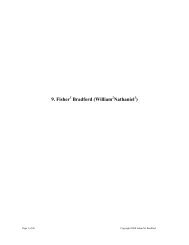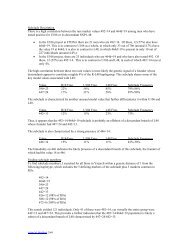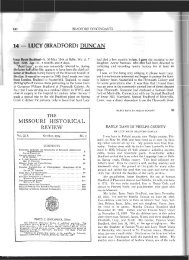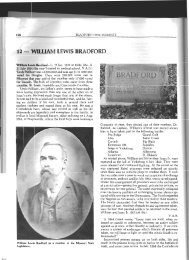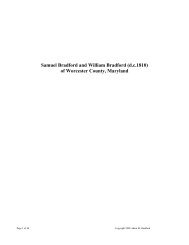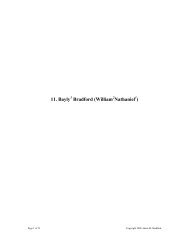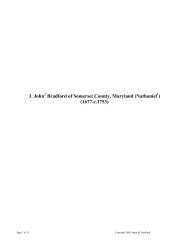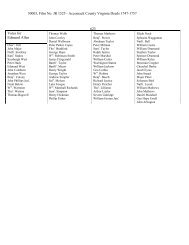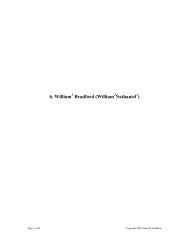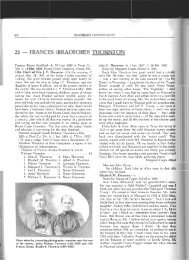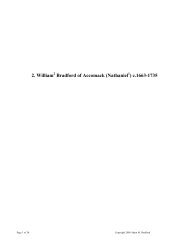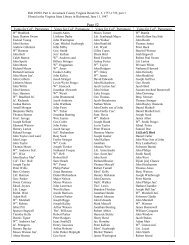1. Nathaniel Bradford of Accomack County, Virginia - Lower ...
1. Nathaniel Bradford of Accomack County, Virginia - Lower ...
1. Nathaniel Bradford of Accomack County, Virginia - Lower ...
Create successful ePaper yourself
Turn your PDF publications into a flip-book with our unique Google optimized e-Paper software.
group <strong>of</strong> about 50 men, including Thomas Johnson, Richard Bayly and others, and set out on April 29 th to<br />
capture the King <strong>of</strong> Pocomoke, who was suspected <strong>of</strong> being the head <strong>of</strong> the conspiracy.<br />
The exact course <strong>of</strong> Scarburgh’s raid is unclear, so it is impossible to determine whether it affected the<br />
Indian villages on Matchapungo Neck, but more than one village appears to have been attacked and several<br />
Indians killed or captured. Scarburgh’s raid was unauthorized and contrary to established Indian policy, and<br />
accordingly on 10 May 1651 the Northampton Court ordered the sheriff to arrest the men who took part.<br />
Justices Argoll Yeardley and William Andrews were sent to James City to prosecute the <strong>of</strong>fenders, and<br />
William Andrews was ordered on behalf <strong>of</strong> the <strong>County</strong> to send<br />
gifts to the Kings <strong>of</strong> Pocomoke and Metomkin as well as to two<br />
Indians whom Scarburgh had abducted and enchained.<br />
Scarburgh and Johnson were singled out for special prosecution<br />
as being the leaders <strong>of</strong> the raid and were indicted by Yeardley<br />
and Andrews for “going in a hostile manner among the Indians<br />
and doing them outrages contrary to the known laws <strong>of</strong><br />
<strong>Virginia</strong>.” However, the authorities at James City must have<br />
sided with Scarburgh since both he and Thomas Johnson were<br />
acquitted. The rest <strong>of</strong> the Justices <strong>of</strong> Northampton were<br />
compelled by Scarburgh’s acquittal to admit that “there is great<br />
probability that the Indians have concluded a confederacy <strong>of</strong> acting a sudden massacre <strong>of</strong> the inhabitants <strong>of</strong><br />
the county.” The Court provided for a company <strong>of</strong> horsemen to be formed to meet the threat. This order<br />
was signed by Stephen Charlton, Colonel Scarburgh and Thomas Johnson, but no other Justices. If further<br />
action was taken against the Indians at this time, it was not recorded – but thereafter relations with the<br />
Indians remained peaceful until 1659, when Scarburgh moved against the Assateagues just north <strong>of</strong> the<br />
Maryland border. Though <strong>Nathaniel</strong> was later a horseman in the <strong>Accomack</strong> militia, it is not clear he was<br />
even on the eastern shore at the time <strong>of</strong> Scarburgh’s 1651 raid, much less whether he took part. 65<br />
* * * * *<br />
The “Art and Mystery” <strong>of</strong> a Currier<br />
By at least 1662, but probably earlier, <strong>Nathaniel</strong> had established himself as a currier, as we learn from two<br />
petitions lodged by Colonel Edmund Scarburgh against <strong>Nathaniel</strong>, given below.<br />
1) [28 January 1662/63] ”Upon the peticon <strong>of</strong> Coll Edm: Scarburgh declareing & Complaining<br />
that hee hath bin at a vast charge for tanning & making shooes, and that hee hath at this present<br />
nine shoemakers that doe noe work, for want <strong>of</strong> Leather curried w ch is and hath bin through the<br />
neglect <strong>of</strong> <strong>Nathaniel</strong>l <strong>Bradford</strong> Currier who by Act <strong>of</strong> Parliamt is ingaged w th in Sixteene daies in<br />
winter and eight daies in Sumer to curry all hides brought to him upon the penalty <strong>of</strong> paying Ten<br />
Shillings P hide for his defeault The Court takeing the prmises into their serious Consideration<br />
Order that y e Sherriffe cause y e Statute to be produced to the said <strong>Nathaniel</strong>l <strong>Bradford</strong> that hee<br />
may not pretend Ignorance, and also that John Turner & Robert Richardson [N.B. - <strong>Nathaniel</strong>’s<br />
brother-in-law] be appointed viewers & approvers both <strong>of</strong> y e Leather sufficient Tanning and well<br />
& sufficient currying, and in case <strong>of</strong> y e absence <strong>of</strong> either <strong>of</strong> them John Tizand to bee assistant<br />
therein, And that y e y e said <strong>Nathaniel</strong>l <strong>Bradford</strong> bee paid for every hide, well & sufficiently curried<br />
thirty pounds <strong>of</strong> tobacco, or a paire <strong>of</strong> shooes for each large hide, as the Imployer shall thinke fitt,<br />
and this by y e Court allowed as y e greatest <strong>of</strong> payments, and to Continue until y e Court shall be<br />
better informed <strong>of</strong> y e prizes in England.” 66<br />
2) [18 January 1663/64] “Col. Edm. Scarburgh complained about the poor quality <strong>of</strong> leather from<br />
<strong>Nathaniel</strong>l <strong>Bradford</strong>, currier, and desiring that it be improved in the future, requested that the<br />
leather be inspected. The court appointed Charles Ratcliffe, George Crumpe, Thomas Taylor,<br />
Robt. Richardson, and John Parker, tanner, to view the leather and report to the next court whether<br />
the fault lay with the tanner, currier or both.” 67<br />
Page 14 <strong>of</strong> 74 Copyright 2008 Adam M. <strong>Bradford</strong>




